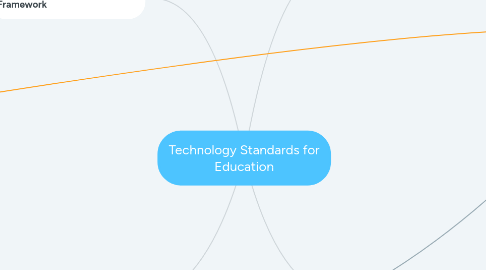
1. Learning and Technology Policy Framework
1.1. Policy 1 Student Centered Learning - Learning is personalized to each students individual needs, skills, and specific interests.
1.1.1. e. monitor their learning progress and inform decisions through the use of data and evidence based reasoning.
1.2. Policy 3 Professional Learning - Provides framework and support for teachers to engage in life long learning, and continuing competence, to maintain the integrity of the profession, and their skills as an educator.
1.2.1. a. are well prepared to use technology and digital resources innovatively and effectively for learning, teaching, leadership and administration.
1.3. Policy 4 Leadership - The education system will develop in a way that supports and promotes innovation, productivity, and student centred learning.
1.3.1. c. seek out and participate in partnership opportunities that support innovative use of technology.
2. ICT Program of Studies
2.1. Communicating, Inquiring, Decision Making and Problem
2.1.1. C7 Students will use electronic research techniques to construct personal knowledge and meaning.
2.1.2. C3 Students will critically assess information accessed through the use of a variety of technologies.
2.1.3. C6 Students will use technology to investigate and or solve problems.
2.2. Foundational operations, knowledge and concepts - includes a focus on the moral and ethical aspect of technology use.
2.2.1. F3 Students will demonstrate a moral and ethical approach to the use of technology.
2.3. Processes for Productivity - students develop an understanding of how to apply digital skills between tools, and leverage them to conduct productive activities and useful means.
2.3.1. P6 Students will use communication technology to interact with others.
3. LINK: Students become the center of the learning process, by developing their own knowledge based on personal meaning, and monitoring their own progress.
4. LINK: The link here is that students learn how to access, filter and utilize massive amounts of data, think critically and assess the data to solve problems and make meaningful decisions.
5. LINK: This linkage allows for students to extend beyond the walls of their classroom, reduces cultural barriers, integrates multiple viewpoints, allows for idea sharing, extends learning capabilities, and fosters global and cultural relations and understanding.
6. LINK: This linkage allows for students to extend beyond the walls of their classroom, reduces cultural barriers, integrates multiple viewpoints, allows for idea sharing, extends learning capabilities, and fosters global and cultural relations and understanding.
7. Demonstrates high level linkages between links. Students are at the center, and actively driving their education.
8. ISTE Standards for Students
8.1. 1. Empowered Learner - Students learn to utilize technology in a way that lets them demonstrate their skills, maximizes their learning, and allows them to drive their own learning experience.
8.1.1. a. Articulate and set personal learning goals, develop strategies leveraging technology to achieve them and reflect on the learning process itself to improve learning outcomes.
8.2. 2. Digital Citizen – Students understand their responsibilities, and the global affect their use of digital technologies, and use them in a self-preserving and ethical
8.2.1. b. Engage in positive, safe, legal and ethical behaviour when using technology, including social interactions online or when using networked devices.
8.3. 5. Computational Thinker - Students learn how to collect, view and assess information and tools, solve problems, and translate into meaningful outcomes.
8.3.1. b. collect data or identify relevant data sets, use digital tools to analyze them, and represent data in various ways to facilitate problem solving and decision making.
8.4. 7. Global Collaborator - Students can harness digital means to engage other students and resources, and engage in collaborations and teamwork to enhance their skills and knowledge.
8.4.1. b. use collaborative technolgies to work with others, including peers, experts or community members, to examine issues and problems from multiple viewpoints.
9. ISTE Standards for Teachers
9.1. 2. Design and Develop Digital Age Learning Experiences and Assessments - Teachers create learning opportunities for students that integrate digital and non-digital means, and allow students to maximize on their learning.
9.1.1. b. Develop technology-enriched learning environments that enable all students to pursue their individual curiosities and become active participants in setting their own educational goals, managing their own learning and assessing their own progress.
9.2. 4. Promote and Model Digital Citizenship – Teachers teach, and are a role model of how to engage digital technologies safely, ethically and responsibly, while understanding global affect.
9.2.1. a. Advocate, model, and teach safe, legal and ethical use of digital information and technology, including respect for copyright, intellectual property and the appropriate documentation of sources.
9.3. 5. Engage in Professional Growth and Leadership - A teachers learning never ends. In order to be an effective teacher, teachers must be life long learners, constantly refining and expanding on their skills and knowledge, particularly as technologies change.
9.3.1. c. Evaluate and reflect on current research and professional practice on a regular basis to make effective use of existing and emerging digital tools and resources in support of student learning.

